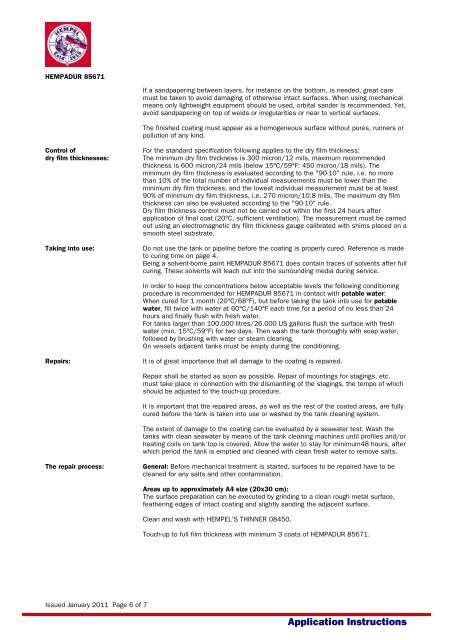English (United Kingdom) - Paul Wurth
English (United Kingdom) - Paul Wurth
English (United Kingdom) - Paul Wurth
- TAGS
- wurth
- www.paulwurth.com
You also want an ePaper? Increase the reach of your titles
YUMPU automatically turns print PDFs into web optimized ePapers that Google loves.
HEMPADUR 85671<br />
Issued January 2011 Page 6 of 7<br />
If a sandpapering between layers, for instance on the bottom, is needed, great care<br />
must be taken to avoid damaging of otherwise intact surfaces. When using mechanical<br />
means only lightweight equipment should be used, orbital sander is recommended. Yet,<br />
avoid sandpapering on top of welds or irregularities or near to vertical surfaces.<br />
The finished coating must appear as a homogeneous surface without pores, runners or<br />
pollution of any kind.<br />
Control of For the standard specification following applies to the dry film thickness:<br />
dry film thicknesses: The minimum dry film thickness is 300 micron/12 mils, maximum recommended<br />
thickness is 600 micron/24 mils (below 15°C/59°F: 450 micron/18 mils). The<br />
minimum dry film thickness is evaluated according to the "90-10" rule, i.e. no more<br />
than 10% of the total number of individual measurements must be lower than the<br />
minimum dry film thickness, and the lowest individual measurement must be at least<br />
90% of minimum dry film thickness, i.e. 270 micron/10.8 mils. The maximum dry film<br />
thickness can also be evaluated according to the "90-10" rule.<br />
Dry film thickness control must not be carried out within the first 24 hours after<br />
application of final coat (20°C, sufficient ventilation). The measurement must be carried<br />
out using an electromagnetic dry film thickness gauge calibrated with shims placed on a<br />
smooth steel substrate.<br />
Taking into use: Do not use the tank or pipeline before the coating is properly cured. Reference is made<br />
to curing time on page 4.<br />
Being a solvent-borne paint HEMPADUR 85671 does contain traces of solvents after full<br />
curing. These solvents will leach out into the surrounding media during service.<br />
In order to keep the concentrations below acceptable levels the following conditioning<br />
procedure is recommended for HEMPADUR 85671 in contact with potable water:<br />
When cured for 1 month (20°C/68°F), but before taking the tank into use for potable<br />
water, fill twice with water at 60°C/140°F each time for a period of no less than 24<br />
hours and finally flush with fresh water.<br />
For tanks larger than 100.000 litres/26.000 US gallons flush the surface with fresh<br />
water (min. 15°C/59°F) for two days. Then wash the tank thoroughly with soap water,<br />
followed by brushing with water or steam cleaning.<br />
On vessels adjacent tanks must be empty during the conditioning.<br />
Repairs: It is of great importance that all damage to the coating is repaired.<br />
Repair shall be started as soon as possible. Repair of mountings for stagings, etc.<br />
must take place in connection with the dismantling of the stagings, the tempo of which<br />
should be adjusted to the touch-up procedure.<br />
It is important that the repaired areas, as well as the rest of the coated areas, are fully<br />
cured before the tank is taken into use or washed by the tank cleaning system.<br />
The extent of damage to the coating can be evaluated by a seawater test: Wash the<br />
tanks with clean seawater by means of the tank cleaning machines until profiles and/or<br />
heating coils on tank top is covered. Allow the water to stay for minimum48 hours, after<br />
which period the tank is emptied and cleaned with clean fresh water to remove salts.<br />
The repair process: General: Before mechanical treatment is started, surfaces to be repaired have to be<br />
cleaned for any salts and other contamination.<br />
Areas up to approximately A4 size (20x30 cm):<br />
The surface preparation can be executed by grinding to a clean rough metal surface,<br />
feathering edges of intact coating and slightly sanding the adjacent surface.<br />
Clean and wash with HEMPEL’S THINNER 08450.<br />
Touch-up to full film thickness with minimum 3 coats of HEMPADUR 85671.<br />
Application Instructions




